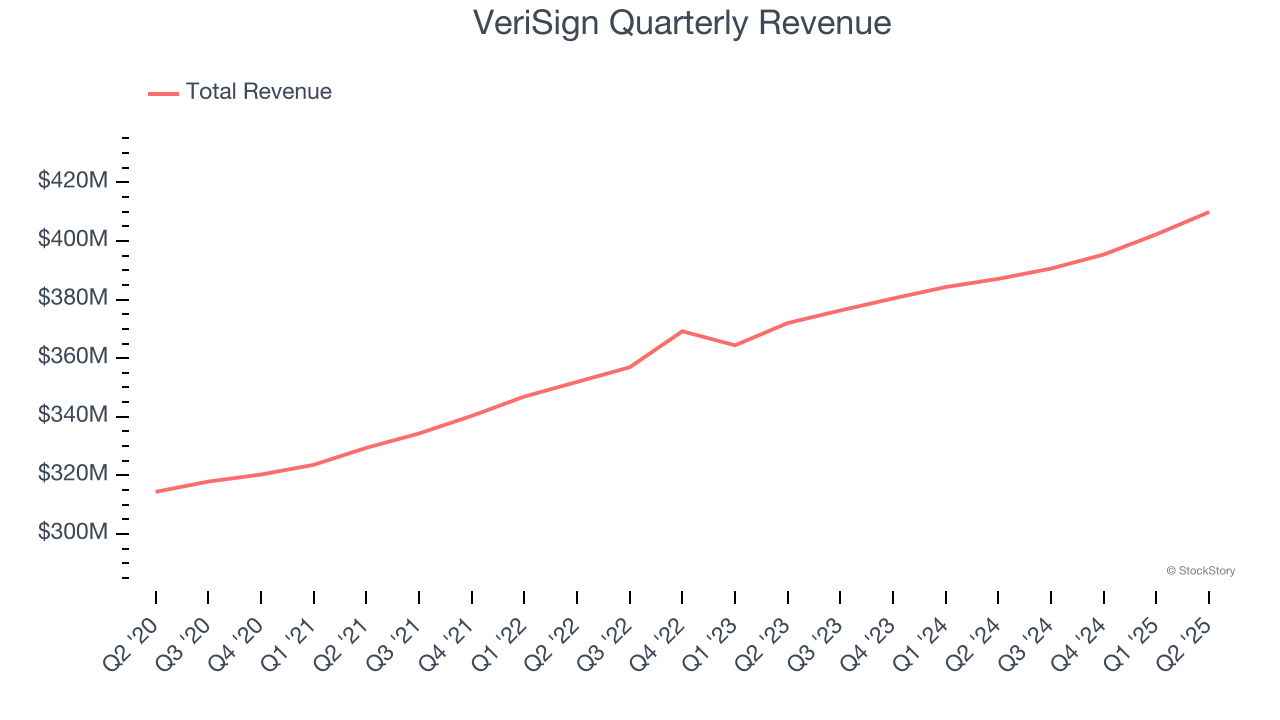
Domain name registry operator Verisign (NASDAQ:VRSN) met Wall Street’s revenue expectations in Q2 CY2025, with sales up 5.9% year on year to $409.9 million. Its GAAP profit of $2.21 per share was 1.4% above analysts’ consensus estimates.
Is now the time to buy VeriSign? Find out by accessing our full research report, it’s free.
VeriSign (VRSN) Q2 CY2025 Highlights:
- Revenue: $409.9 million vs analyst estimates of $411 million (5.9% year-on-year growth, in line)
- EPS (GAAP): $2.21 vs analyst estimates of $2.18 (1.4% beat)
- Operating Margin: 68.5%, in line with the same quarter last year
- Free Cash Flow Margin: 47.5%, down from 71% in the previous quarter
- Market Capitalization: $27.17 billion
Company Overview
While the company is not a domain registrar and does not directly sell domain names to end users, Verisign (NASDAQ:VRSN) operates and maintains the infrastructure to support domain names such as .com and .net.
Revenue Growth
Examining a company’s long-term performance can provide clues about its quality. Even a bad business can shine for one or two quarters, but a top-tier one grows for years. Over the last three years, VeriSign grew its sales at a weak 5.2% compounded annual growth rate. This wasn’t a great result compared to the rest of the software sector, but there are still things to like about VeriSign.

This quarter, VeriSign grew its revenue by 5.9% year on year, and its $409.9 million of revenue was in line with Wall Street’s estimates.
Looking ahead, sell-side analysts expect revenue to grow 4% over the next 12 months, similar to its three-year rate. This projection is underwhelming and implies its products and services will see some demand headwinds. At least the company is tracking well in other measures of financial health.
Today’s young investors won’t have read the timeless lessons in Gorilla Game: Picking Winners In High Technology because it was written more than 20 years ago when Microsoft and Apple were first establishing their supremacy. But if we apply the same principles, then enterprise software stocks leveraging their own generative AI capabilities may well be the Gorillas of the future. So, in that spirit, we are excited to present our Special Free Report on a profitable, fast-growing enterprise software stock that is already riding the automation wave and looking to catch the generative AI next.
Customer Acquisition Efficiency
The customer acquisition cost (CAC) payback period measures the months a company needs to recoup the money spent on acquiring a new customer. This metric helps assess how quickly a business can break even on its sales and marketing investments.
VeriSign is very efficient at acquiring new customers, and its CAC payback period checked in at 25 months this quarter. The company’s rapid recovery of its customer acquisition costs means it can attempt to spur growth by increasing its sales and marketing investments.
Key Takeaways from VeriSign’s Q2 Results
Revenue was in line and EPS exceeded expectations by a small amount. Overall, this quarter didn't have too many surprises. The stock remained flat at $285 immediately after reporting.
The latest quarter from VeriSign’s wasn’t that good. One earnings report doesn’t define a company’s quality, though, so let’s explore whether the stock is a buy at the current price. If you’re making that decision, you should consider the bigger picture of valuation, business qualities, as well as the latest earnings. We cover that in our actionable full research report which you can read here, it’s free.
